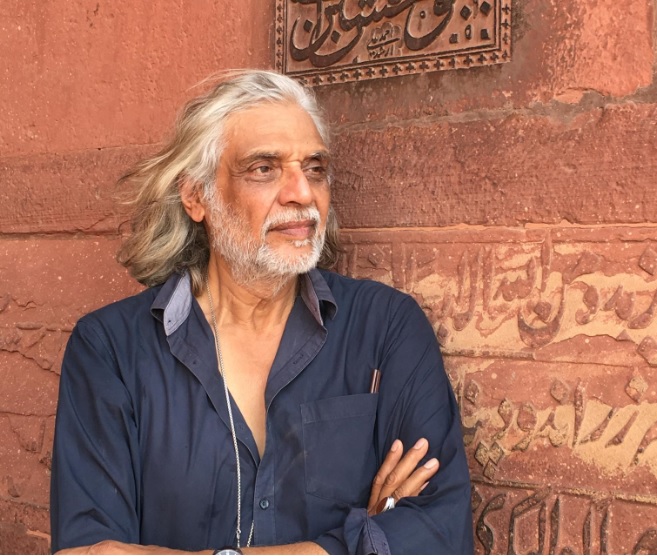Dr Alka Pande is an art historian who has taught Indian Arts and Aesthetics at Panjab University for over ten years. Her major interests include gender identity, sexuality, and traditional arts. She has received numerous awards, including the Knight of the Order of Arts and Letters, the Australian-India Council Special Award, and Chandigarh Lalit Kala Akademi honours to mention a few. Pande has also been involved in curating exhibitions and has been awarded the CIMA Lifetime Achievement Award 2023. She is currently the head of the Visual Art Gallery at the India Habitat Centre, New Delhi. Dr Pande also set up the Bihar Museum Biennale in 2021 and is now the chief curator for the Bihar Museum Biennale.
Recently Dr. Alka Pande released her monumental work, “108 Portraits of Indian Culture and Heritage.” This immersive collection of 14 collectable books, each exploring a distinct discipline such as art, architecture, objects, crafts, and more, showcases her dedication and expertise in the field of Indian art and aesthetics. Dr. Pande’s ability to encapsulate India’s rich cultural history, including illuminating art, architecture, and cultural landscape, while interweaving personal anecdotes, serves as a remarkable source of inspiration. Her work is not only lauded as an invaluable resource for scholars and enthusiasts but also recognised for its significant contribution to preserving and promoting India’s cultural heritage.
Nidheesh: This helps to paraphrase and connect the world, which may not be familiar with these Indian traditions, to understand them better.
Dr Pande:Well, you’re right about that, but basically, for me, it is to sensitize the people about the beauty and the inclusiveness of the Indian way of thinking, Indian philosophy, Indian thought, Indian art practice, and also to show the world how cosmopolitan and how universal we are. It’s not that it is only limited to the subcontinent. Yes, in traditional art, how many people will understand the concept of a Dashabhuja Durga and a ten-headed Ravana? So, that is why Partha Mitter wrote the book “Much Maligned Monsters” because people in the West do not understand this concept. Because we are also about myths and legends, and all of them have a reason. They may not be written history, but they talk of the cultural thinking of the people and the culture of every geography, every region that you grow up in, every district, every state, then the nationhood. There is a cultural mapping and a cultural identity to that. So, these books help you discover the cultural mappings which are present in our beautiful country. I mean, AL Basham had written a book called “The Wonder That Was India.” I like to say the wonder that ‘IS’ India.
Nidheesh: That’s great. Coming to your curatorial works, I mean, this Bihar Museum was a great Biennale, was a great event, and now you’re saying that you’re going to do something similar in Patna. So, what was that experience, and how did you think about it? I think that was the first Biennale Patna was seeing, right?
Dr. Pande: Yeah, so you know, things like this, the origin of ideas always begins with human beings. It always starts with a person. So, in Bihar, I met this great visionary called Anjani Kumar Singh, who was the Chief Secretary of the State, and now he’s the adviser to the Chief Minister, Shri Nitish Kumar ji. He was responsible for ensuring that the vision of the Chief Minister Nitish Kumar is completed in the form of this beautiful museum called the Bihar Museum. An extraordinary museum made in post-independent India by a Japanese architect called Fumihiko Maki. It’s extraordinary because in the main city of Patna, you have this absolutely modern building which talks of the glory of Bihar and uses particular materials which reflect the imperial grandeur of Bihar, as you know, in many ways was or Patiputra – Patna. Patliputra and Magadh, these were the areas situated in Bihar, and Bihar was the first place where the Republic was born, where the 16 Mahajanapadas were brought under one imperial control by Chandragupta Maurya. So, you have so much richness in Bihar, the artifacts in Bihar, so the museum became a perfect backdrop to develop the Bihar Museum Biennale, which was developed as the vision of Shri Anjani Kumar Singh, and I executed it. We decided that everybody, there is a Kochi Biennale, there’s an Art Biennale, there are many Biennales, but nobody has really looked at a museum. And the museum today, not just in India but all over the world, is becoming a laboratory of ideas, it’s being transformed and changed. It is no longer just an archaeological museum where you put antiquities and let it be. It is a very dynamic space. There’s a great amount of visitor experience which happens there. There’s a great dialogue between objects and the viewer. Sometimes museums don’t even have objects; there is a museum of sense happening, there’s a museum of taste which is taking place. So, there are many kinds of museums which are coming across the world. So, the ecosystem of the museum itself is giving great food for thought, and museums across the country and the world are creating new vectors of knowledge and information. So, to have debates around the museum, about the museum and what the museum or curatorial strategies can be of museums, became very interesting, and we got a fabulous response. For the last Biennale, we had people from the Humboldt Centre in Germany, we had people from Abu Dhabi, we had people from Australia, we had actually everybody. We had the architect Haka Warde, who was in the design team of Jean Nouvel who had done the Louvre Abu Dhabi. So, we had everybody with us, and we talked a lot about it, and great debates happened, and there was a lot of learning and sharing. But what I’m doing now is that the old Patna Museum, which was set up in 1917, is also undergoing a great change. And with Drona, who is responsible for bringing out the conservation of the newly or the renovated Patna Museum, I’m curating an outdoor Sculpture Park which is going to showcase some of the most beautiful sculptures from the fifth or sixth century. In fact, I’ve been working on the panels right here; you will see we have divided it into different cultural groups like Anga, yes, all of these. So, this is the work I’m doing and putting objects, and we’ve got fabulous objects in Patna. So, the Patna museum is actually going to be from post Buxar 1764 to present times, and we’re going to have a huge Ganga Gallery there. So, we’re going to talk about what happens around the Ganga, life around the Ganga, minerals, all kinds of artefacts which have been found on this cultural mapping of the Ganga, and then of course, the great Chhat Puja will also be shown in the Ganga Gallery.





